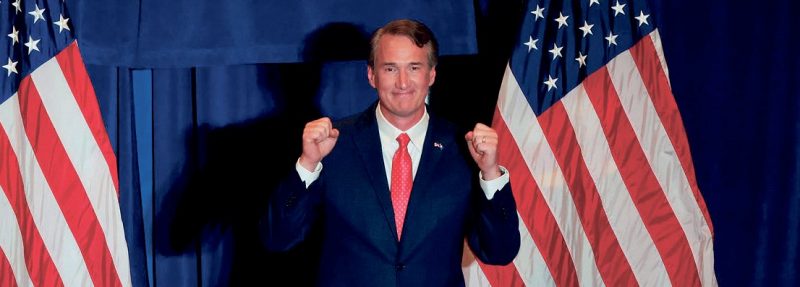Republican Gregg Youngkin’s victory in Virginia’s Nov. 2 gubernatorial election is credited to many factors but none more significant than racism.
As The Guardian’s David Smith wrote, Youngkin “promised to ban critical race theory from Virginia’s schools on his first day in office. It mattered little that CRT, an academic discipline that examines the ways in which racism operates in U.S. laws and society, is not taught in Virginia’s schools but has become a catch-all for any teaching about race and American history.”
Smith, and others, noted that this was not the first time the “right dog-whistle” was blown during an election. Richard Nixon’s “law and order” campaign in 1968 appealed “to racial fear and resentment without using overtly racist language” in the South. Ten years later, Ronald Reagan attacked “welfare queens” to demonize African American women, basing it on just one person, Linda Taylor, without naming her.
Ten years after that, George H.W. Bush’s campaign spotlighted Willie Horton, an African American serving a life sentence who committed rape during a furlough from prison when Bush’s opponent, Michael Dukakis, was governor of Massachusetts. His campaign manager Lee Atwater “understood that racial resentment animates a lot of white suburban voters and you can manipulate that to get people to the polls. Critical race theory now is the modernday version of the Southern strategy,” Tara Setmayer, a senior adviser to the anti-Trump Lincoln Project, told Smith.
The Huffington Post’s Paul Blumenthal agreed, adding, “The issue of the teaching of critical race theory … in public schools provided an ambiguous enough target to mobilize the rural Trump base to go to the polls while overlapping the issue with other education-related anxieties for persuadable suburban voters.”
The architects of the strategy of “Trumpism without Trump,” as the Guardian headlined Smith’s story, followed the same playbook. Their Willie Horton, astonishingly, was Toni Morrison’s 1987 Pulitzer Prize-winning novel “Beloved” about a fictional mother who killed her fictional infant daughter rather than having her grow up in the very real world of slavery. It came courtesy of Laura Murphy, who said that she tried to have “Beloved” banned from her son’s school eight years ago after he complained about it. McAuliffe, then governor, twice vetoed legislation to ban books in Virginia, which turned into a major campaign issue.
But CRT’s injection into the Virginia race was not spontaneous. Columbia Law School professor Patricia J. Williams noted in The Nation that, by the time of the election, eight states had passed laws banning CRT from public schools, with bills pending in 20 others. “The language of the laws is almost identical, having been drafted not at the local level but by a team coordinated and funded by an array of conservative think-tanks, including the Manhattan Institute, the American Enterprise Institute, and the Heritage Foundation,” Williams reported.
Williams noted also that the war against CRT gained speed after then President Donald Trump issued an executive order banning it from schools, for which Christopher Rufo, a Manhattan Institute senior analyst, took credit. Rufo tweeted that his goal was to “run a public persuasion campaign lumping any number of topics under the general heading of critical race theory.”
“We have successfully frozen their brand –‘critical race theory’ – into the public conversation and are steadily driving up negative perceptions,” Rufo wrote. “We will eventually turn it toxic, as we put all of the various cultural insanities under that brand category…. The goal is to have the public read something crazy in the newspaper and immediately think ‘critical race theory.’ We have decodified the term and will recodify it to annex the entire range of cultural constructions that are unpopular with Americans.”
Makes for better campaign propaganda than calling for a national conversation over the enslavement of 700,000 Africans by 1790 and the lynching of at least 4,400 in 12 Southern states, including 331 in Florida, between 1877 and 1950, according to the Alabama-based Equal Justice Initiative. Nor would it do to raise the issue of at least 1,100 others whom the Civil Rights and Restorative Justice Project, headed by Northeastern University professor Margaret Burnham, has so far identified as having been murdered in racially motivated violence between 1930 and 1955 alone and ignored by the authorities.
In Miami-Dade County, the Truth, Education, and Reconciliation (TEAR) initiative is pursuing a similar goal as it seeks justice for lynching victims J.B. Harris, William Simmons and Roy Gaines, according to a press release. TEAR was launched in 2018 by Barry University, South Florida People of Color, Virginia Key Beach Park Trust and longtime activist Marvin Dunn, the release says. The group will meet at 10 a.m. Saturday, Nov. 13, at Sweet Home Missionary Baptist Church,10701 SW 184th St., West Perrine, and organizers are inviting the community “to join a crucial journey toward justice and healing.”
That, rather than denunciation of CRT, and an honest discussion of the nation’s slavery past and ongoing racism, should be the goal for leaders. Rufo may gloat about being the new Atwater, Younkin may be proud to be the new Bush who successfully demonized a classic work of literature to win election, even as millions of Americans remain continue to plead, “Please, massa, suh, let us poor black folks vote” and “Please, massa, suh, tell your police to stop killing us poor black folks.”
Democrats may lose again in 2022 and 2024 because of the racist dogwhistle. But getting cute and playing politics with critical race theory, which is of fundamental importance to African Americans, will not change the fact that so long as there is a single human being left on the planet, so long will the story live on of how one group of people enslaved another because of their skin color and kept the shackles on in one form or other. Shame on them all.









No Comment